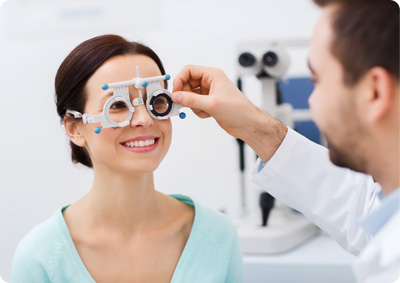LensShopper - Contact lens price comparison
Eye disorders and refractive errors
There are a number of different eye disorders and vision errors that can occur for several reasons. Some emerge at an early age while others make themselves known at a later stage in life. What causes these different vision errors and what can you do to correct them? To give you the answers to these questions, we need to start by figuring out how our vision works.

How does our vision work?
All visual impressions arise when light rays from the surroundings enter the eye through the pupil. Through the cornea, the light is refracted and continues into the eye through the lens to then reach the retina. The image is filtered and processed as soon as it reaches the retina, and then sent to the brain's vision center for a complete interpretation.
The eye can be compared to a camera
Many times, you use the parable between the eye and a camera to more easily understand how vision works. Just like a camera, the eye needs to set focus so that what you are looking at is perceived sharply and clearly. The eye's equivalent to the film roll, the retina, contains light receptors that require a focused image. When the light is focused on the retina, it is usually said that the optical conditions have been achieved for a sharp and clear image. However, if the focus of light falls behind or in front of the retina, a blurred image will appear.
Rods and cones - retina visual cells
Rods and cones are two types of visual cells that are found in the retina. The "yellow spot" consists mainly of rods that make sure you can distinguish colors and get sharp vision. Outside this area we find the cones, which among other things make sure we can see in the dark. In order to quickly move focus from different objects at different distances, the eye uses a number of small muscles. These muscles ensure that you, who have normal vision, get the right refraction of the light rays, so that the focus always gets on the retina and you get a sharp image whether it is near or far away. This adjustment is taken care of the eye itself automatically and is not something you notice in your everyday life. If this doesn't work properly, you probably have some type of visual defect and need glasses or contact lenses to help the eye refract light properly.
Emmetropia - You have no refractive errors
At birth, most children are farsighted, but as the child grows up, the eye develops and becomes longer, which weakens myopia. You say that you go from farsightedness to ideal vision (emmetropic) when the focus of light falls on the retina. This process is a natural development of the eye and should subside as soon as the eye has become fully developed. In some cases, however, this development continues beyond ideal vision and turns into nearsightedness.
A person who has ideal vision may also have vision problems. These problems are then usually linked to the cooperation between the eyes, for example in some form of discernment. Usually, the person with ideal vision does not experience any problems with the vision until he / she becomes of age.
Different eye disorders
Astigmatism, myopia, hyperopia and ageing eyes are all examples of vision errors/eye disorders that you can get help to correct. Below you can read more about how these eye disorders affect your vision. Follow our internal links below for more in-depth information on respective vision error.
- Astigmatism
One can easily summarize astigmatism with a condition where the lens or cornea has an irregular shape, more oval than round. Because of this irregularity, a refractive error occurs that affects the light flowing into your eyes. Here you can read more about Astigmastim and how to correct this eye disorder. Myopia
Myopia, or as it is commonly referred to in daily speech - nearsightedness, is a visual impairment that allows you to have good eyesight at close range but worse at longer distances. This visual error is often due to hereditary factors, but external environmental factors can also have an impact on this eye disorder. Read more about myopia and what you can do to remedy it.- Hyperopi
If you can see distant objects clearly but things that are all around you become blurred, then you probably suffer from farsightedness (Hyperopia). Simply put, it is easier for your eyes to focus on objects that are further away than things near you. Here you can read more about hyperopia and what you can do to get help. Presbyopia
As we get older, the eye's ability to focus at different distances decreases, our proximity is affected and we find it harder to see focused up close. This is called ageing eyes (Presbyopia) and will affect us all. Read more in depth about presbyopia and get tips and advice on how to correct this age-related eye condition.
Best prices - 1 Day Acuvue Moist
- 1.
- $42.9842.98
- Discount Conta..
- 2.
- $44.7444.74
- Fresh Lens
- 3.
- $51.9951.99
- 1-800 Contacts
Search for more 1 Day Acuvue Moist contacts here!









 1 Day Acuvue Moist
1 Day Acuvue Moist Dailies AquaComfort Plus
Dailies AquaComfort Plus Acuvue Oasys 1-day With Hydraluxe
Acuvue Oasys 1-day With Hydraluxe